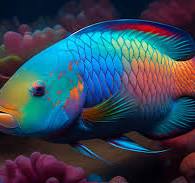Parrotfish: Vibrant Guardians of Coral Reefs and Ecosystem Balance
Parrotfish, colorful denizens of tropical coral reefs, are among the most fascinating and ecologically important creatures inhabiting these vibrant underwater ecosystems. With their distinctive beak-like mouths and kaleidoscopic hues, parrotfish belong to the family Labridae and are known for their crucial role in maintaining coral reef health.
Anatomy and Appearance
Parrotfish are named for their unique dental structure, which resembles a parrot’s beak. This adaptation allows them to scrape algae and small organisms off coral and rocks, contributing significantly to reef cleaning and health. Their bodies are often vividly colored, ranging from shades of blue, green, and yellow to more muted tones, camouflaging them against the reef’s complex backdrop.

Rainbow Parrotfish
Habitat and Distribution
Found predominantly in tropical and subtropical waters worldwide, parrotfish thrive in coral reef environments where they play an essential ecological role. These environments provide the algae and coral they feed upon, making them integral to the delicate balance of reef ecosystems.
Ecological Importance
- Algae Control: Parrotfish are voracious consumers of algae, preventing it from overgrowing and smothering coral reefs. Their grazing behavior helps to maintain a healthy balance between coral and algae, crucial for reef resilience.
- Coral Sand Production: Surprisingly, parrotfish are major contributors to the formation of coral sand. They ingest coral as they feed and grind it up with their strong jaws. This process results in fine sand that forms beaches and contributes to the structure of coral islands.
- Biodiversity Support: By shaping reef structure through their feeding habits, parrotfish create diverse habitats for other marine species. Their actions contribute to the overall biodiversity of coral reef ecosystems.
Life Cycle and Behavior
Parrotfish exhibit a variety of behaviors that are both fascinating and critical to their survival:
- Sexual Dimorphism: Male and female parrotfish often differ in color and markings, with males typically being more brightly colored.
- Protogynous Hermaphrodites: Many parrotfish species are protogynous hermaphrodites, beginning life as females and later changing into males. This adaptation helps maintain population dynamics and reproductive success within their communities.
- Social Structure: They are often found in schools or solitary, depending on the species and environmental conditions. Some species exhibit complex social behaviors, including hierarchical structures and mating rituals.
Conservation Challenges
Despite their ecological importance, parrotfish face significant threats:
- Overfishing: Targeted fishing for their meat and scales reduces their numbers, disrupting coral reef ecosystems.
- Habitat Destruction: Coral reef degradation due to climate change, pollution, and coastal development directly impacts parrotfish populations and their ability to perform vital ecological functions.
Conservation Efforts
Efforts to protect parrotfish and coral reefs include:
- Marine Protected Areas: Establishing and enforcing protected zones where fishing is restricted helps conserve parrotfish populations and their habitats.
- Community Engagement: Educating local communities about the importance of parrotfish in reef ecosystems encourages sustainable fishing practices and conservation efforts.
In conclusion, parrotfish are not only visually striking inhabitants of coral reefs but also essential players in their ecosystem’s health and resilience. Understanding and protecting these colorful fish are crucial steps towards safeguarding the biodiversity and ecological balance of our planet’s underwater treasures.

Parrotfish
- Posted in:
- Conservation
- Coral Reefs
- Marine Biology
